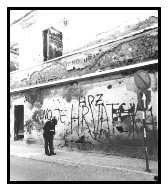![[Menu]](/buttons/buc_menu.gif)
![[dDH]](/buttons/buc_ddh.gif)
Volunteer Project Pakrac
About the Pakrac Area: History and Current Situation
The town of Pakrac in Western Slavonia is now starting to
rebuild following four years of war, destruction and ethnic
division. The latest violent conflict, in a long history of
war in this region, started in 1991. Before the war the town
numbered around 9,000 inhabitants which consisted of 48%
Serbs and around 35% Croats as well as Hungarian, Italian
and Czechs minorities. Nowadays, Pakrac has around 4,000
inhabitants and is 70% destroyed. Most of the population
fled during the fighting as the town changed hands five
times. The cease-fire brought by the UN after six months
meant that the town was divided by a cease-fire line.
Civilians returned on either side, but fighting still
continued sporadically across the line until May 1995 when
the Croatian army overran the Serbian side. Most of the
Serbian population then left. Nevertheless the Serbian
community in this area is still the biggest cohesive Serbian
community on the whole territory of Croatia under government
control (about 1000).
The cease-fire line no longer exists, so people are able to
move freely from one part of the town to another. That means
that obstacles for communication between the communities are
no longer so visible. Although there are no physical
barriers for communication between the two communities,
psychological barriers are stronger then ever. Croats feel
victorious and vengeful while Serbs feel humiliated and
scared.
 Both communities live in poor economic conditions as
Pakrac is a ruined town with an economy that barely
functions and few resources for reviving its agricultural
production. Economic troubles in combination with personal
psychological traumas and the state media's war propaganda
contribute a great deal to tensions between and within the
communities.
Both communities live in poor economic conditions as
Pakrac is a ruined town with an economy that barely
functions and few resources for reviving its agricultural
production. Economic troubles in combination with personal
psychological traumas and the state media's war propaganda
contribute a great deal to tensions between and within the
communities.
[Menu]
[dDH]
 Both communities live in poor economic conditions as
Pakrac is a ruined town with an economy that barely
functions and few resources for reviving its agricultural
production. Economic troubles in combination with personal
psychological traumas and the state media's war propaganda
contribute a great deal to tensions between and within the
communities.
Both communities live in poor economic conditions as
Pakrac is a ruined town with an economy that barely
functions and few resources for reviving its agricultural
production. Economic troubles in combination with personal
psychological traumas and the state media's war propaganda
contribute a great deal to tensions between and within the
communities.